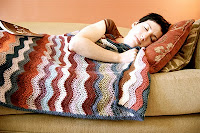There are several reasons for napping. Most commonly, we experience a natural energy low in the early afternoon, roughly eight hours from the time we woke. This, in fact, was the basis for the Dr. Pepper marketing campaign, “Drink a bite to eat at 10 o’clock, 2 o’clock, and 4 o’clock!” (Flaherty). The idea was that a dose of caffeine and sugar in this crucial early afternoon period would help you get back on your feet and be productive at work. To explain this natural energy low, many studies point to the body’s circadian rhythm – the internal body clock that controls periods of rest and wakefulness. The thinking is that we are bi-phasic sleepers and naturally need two (or more) periods of rest.
We also feel a strong tendency to nap when we are sick or fighting sickness. The body encourages us to get more rest, which in turn allows it to dedicate more time and resources to fighting the invading pathogen. In today’s busy world, we also use naps to counteract the so-called, “sleep debt.” The idea being that we accrue a “debt” of lost sleep over time if we get any less sleep at night than our own bodies naturally require.
A brief explanation of sleep itself helps illuminate the nap. When we sleep, our bodies tend to go through certain stages, each with its own characteristics. First, we enter the Non-Rapid Eye Movement (NREM) Stage 1. As we transition to this stage, we oftentimes experience the “hypnic jerk.” This is that annoying, panicky feeling (like you are suddenly falling through air) that causes you to jerk or spasm as you are trying to rest.
We then progress through NREM Stage 2 (shallow sleep) to NREM Stage 3 – where the deepest, “slow-wave” sleep takes place. It is in this stage, about 25-30 minutes after lying down, that we finally begin to dream, though the majority of our dreams occur in REM sleep. It is believed that once we enter the slow-wave sleep of N3, we have begun a period of potential “sleep inertia.” If we are suddenly awakened now before the sleep cycle completes itself, we often experience profound grogginess, lack of coherence or motor coordination, and an intense desire to return to sleep.
After making it through a stage of N3, we often re-enter NREM Stage 2 and then transition to the more widely-known Rapid Eye Movement (REM) sleep. This stage accounts for about 20-25% of our nightly sleep, and it is the stage in which most dreaming (and the most memorable dreaming) takes place.
This progression of sleep stages completes a sleep cycle. Current wisdom holds that a sleep cycle lasts for roughly 90-100 minutes. Ergo, if your nap lasts more than 20-30 minutes (where the deep N3 begins), you should aim to sleep for no less than the full hour-and-a-half for fear of sleep inertia.
Ergo, the power nap, a term attributed to social psychologist James Maas. Allowing yourself to rest for 20-25 minute periods so as to benefit from NREM Stages 1 and 2 but avoid falling into Stage 3 constitutes a power nap that is said to revitalize and rejuvenate you. On the flip side, some practice power naps at 90 or 180 minute intervals, but the key is to avoid waking in the middle of a cycle.
Polyphasic sleep is the practice of using these power naps at regular intervals throughout the day to supplement our standard nightly rest. Wikipedia has a great summary of polyphasic sleep if you’re interested in learning more. It gets quite complex.
An interesting way to make power naps more powerful is to have a strong dose of caffeine (i.e. espresso or a good amount of coffee) immediately before one of these 20-30 minute naps. It takes caffeine just about this long to produce its alerting or ‘wiring’ effect in the body, so as your nap alarm wakes you up, you feel both the biological and chemical boosts.
Lastly, it can be difficult to achieve a restful sleep in only 20-30 minutes if you are not accustomed to the practice. Many people spend longer than this tossing and turning at night before they even can sleep. I have personally found binaural beat sound tracks such as those produced by the Pzizz program to be incredibly effective and helpful for this. Binaural beats, simply put, are deeper tones that coax the brain into deeper levels of rest (or trance) more quickly. I use my Pzizz iPhone app daily, but there are many solutions out there.
Hopefully, with a deeper understanding of naps and how to most effectively use them, you’ll be able to get more done during the day with more energy and creativity. Although in today’s working world the line between home and work blurs, people are recently getting even less sleep as they work harder to make ends meet through the recession. May this article help you, your friends, your family, and your coworkers!
Do you have any tips to add or share?
Comment and share to keep the discussion going. And subscribe via Email or by RSS if you like this blog!
Photo credits: 365.24 by kpwerker
Nap #2 by * Yumi *
digital-drug-binaural-beat by digitalbob8

 We say it as much for ourselves as we do for our kids: “nap time.” Theories abound as to the best way to nap, but honestly most people have never looked into the science behind the ritual. A deeper understanding of the short sleep we call a nap can help us to benefit much better from it.
We say it as much for ourselves as we do for our kids: “nap time.” Theories abound as to the best way to nap, but honestly most people have never looked into the science behind the ritual. A deeper understanding of the short sleep we call a nap can help us to benefit much better from it.


10 pings
Skip to comment form ↓